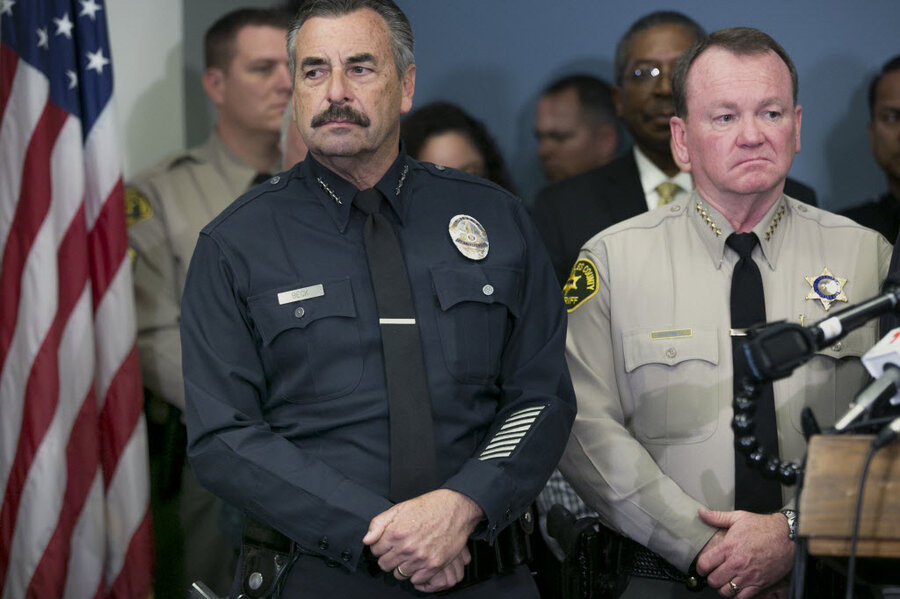New York City and Los Angeles school threats: A tale of two districts
Loading...
When parents, teachers, and children in Los Angeles and New York City woke up Tuesday morning, they were in for very different days: different from a typical school day, with anxiety and security concerns spiking thanks to school threats received Monday night, but also different from each other, as Angelenos sat tight at home, and New York children marched off to class as usual.
School officials' sharply contrasting responses to similar threats, received via email on Monday evening, prompted immediate comparisons and, at times, criticism. Although police on both sides of the country ultimately determined the messages to be a hoax, information gaps, local worries, and word-by-word analysis guided America's two largest K-12 districts toward their separate decisions: in New York, 1.1 million kids went to class, while hours later, the families of Los Angeles' 640,000 pupils scrambled to find childcare after all of the district's 900 schools were closed for the day.
Around 1 a.m. Eastern time on Tuesday — 10 p.m. Monday on the West Coast — school officials in both cities received similar threats via email and immediately alerted police, and then the FBI. Both messages promised large-scale terror: the emails, which appeared to come from a German server, threatened jihadi-related attacks with guns and bombs placed in lockers and backpacks, in a "very broad ... but also very specific" way that concerned L.A.'s Police Chief Charlie Beck.
The L.A. emails listed each individual school in a district covering more than 700 square miles, one factor in Superintendent Ramon Cortines's decision to close and search each one. (Schools will reopen Wednesday, with police on guard and counseling available to students.)
The emails used "very good English — which is not a good sign," Chief Beck said, according to the Los Angeles Times. "Most of the hoaxes that I see ... have syntax errors, a lot of incomplete sentences, non-sequiturs. So that concerned me."
In New York, however, one typo caught officials' attention. The message threatened that "138 comrades" would join the writer, who claimed to be a bullied high school student. "The students at every school in the New York City school district will be massacred, mercilessly. And there is nothing you can do to stop it," he or she bragged.
But "Allah," the Arabic word for God, was not capitalized, which contributed to investigators' doubts.
"It didn't add up," said Stephen Davis, deputy commissioner of the New York Police Department, noting that it is rare for genuine threats to describe potential attacks in such detail.
Before the start of school, New York officials learned L.A. had received similar messages, with the sender claiming to be in both cities.
NYPD Commissioner William Bratton dismissively compared the threats to "Homeland," a political thriller TV series, and other NY officials deemed it a "generic" hoax, and said that canceling school would be a potentially dangerous overreaction.
"If this was not ISIS, not a terror organization, they're nonetheless watching," California Rep. Adam Schiff (D) told "Meet the Press" on Wednesday. "If they come to the conclusion that they can literally mail it in, call it in and disrupt large cities, they're going to take advantage of that."
L.A. officials, however, did not learn of NYC's threats until after announcing school closings, according to the L.A. Times.
But the city's district leaders and police strongly objected to criticism of their decision. Beck called such objections "irresponsible."
"We have suffered too many school shootings in America to ignore these kinds of threats," he said. Los Angeles is just an hour away from San Bernardino, where a radicalized couple killed 14 people in a gun massacre December 2.
But the schools' responses may have differed with or without the influence of San Bernardino. "Los Angeles doesn't have that same kind of experience" with antiterrorism work as New York City, Victor Asal, the chair of public administration at the State University of New York at Albany, told the Associated Press. "I would expect the two cities to react differently."
"These decisions are not something you get to do over again if you turn out to be wrong," L.A.'s Beck said Tuesday.
US school districts are becoming increasingly accustomed to evaluating such threats. According to the most recent analysis from National School Safety and Security Services, there were 812 threats against American schools in the first half of 2014. Districts closed schools in about 10 percent of those cases.
"From a psychological standpoint, that’s exactly what terrorism is: It’s to provoke fear so that your operations stop," Radford University Professor Tod Burke told The Christian Science Monitor.
This report contains material from Reuters and the Associated Press.








